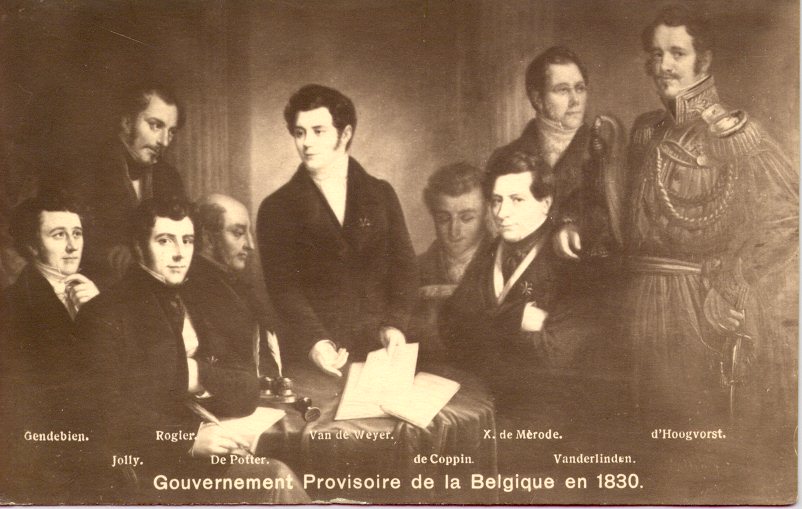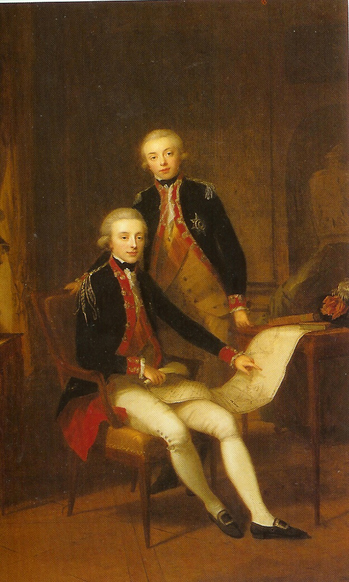|
Matilde Malenchini
Matilde Malenchini, née Meoni (3 December 1779 – 8 September 1858) was an Italian portrait and genre painter in the Academic style. Biography She was born in Livorno. In 1796, she married Vincenzo Francesco Malenchini, a painter and musician.Mario Battistini, "Livornesi amici di Luigi de Potter: la pittrice Malenchini, Antonio Benci e Pompeo Anichini", in ''Bollettino Storico Livornese'', Direttore Ersilio Michel, #1, Deputazione Toscana di Storia Patria-sezione di Livorno, Jan-Mar 1937, p. 62. Although they soon separated, she retained his name for the rest of her life. In 1807, she entered the Accademia di Belle Arti di Firenze, where she studied under the guidance of Pietro Benvenuti. During these years, for practice and for pay, she copied the works by old Italian and Dutch masters at the Uffizi Gallery. In 1811, she received a four-year annual stipend from Elisa Bonaparte to study in Rome at the "Pontificia Accademia romana delle belle arti di San Luca".Marijcke Schilli ... [...More Info...] [...Related Items...] OR: [Wikipedia] [Google] [Baidu] |
Louis De Potter
Louis de Potter (26 April 1786 – 22 July 1859), was a Belgian journalist, revolutionary, politician and writer. Out of the more than 100 books and pamphlets, one of the most notable works was his famous ''Letter to my Fellow Citizens'' in which he promoted democracy, universal electoral rights and the unity among Belgian liberals and Catholics. As one of the heroes of the Belgian Revolution, he proclaimed the independence of Belgium from the Netherlands (from the terrace of the Brussels City Hall on 28 September 1830), and inaugurated the first Belgian parliamentary assembly (on 10 November 1830), on behalf of the outgoing Belgian provisional government. Life De Potter belonged to a rich noble family (his father was the Esquire Clément de Potter de Droogenwalle) which sought asylum in Germany after the second French invasion of the Southern Netherlands in 1794 and remained there until the Consulate. This meant that Louis's education in Bruges remained largely incomplete and ... [...More Info...] [...Related Items...] OR: [Wikipedia] [Google] [Baidu] |
Italian Women Painters
Italian(s) may refer to: * Anything of, from, or related to the people of Italy over the centuries ** Italians, an ethnic group or simply a citizen of the Italian Republic or Italian Kingdom ** Italian language, a Romance language *** Regional Italian, regional variants of the Italian language ** Languages of Italy, languages and dialects spoken in Italy ** Italian culture, cultural features of Italy ** Italian cuisine, traditional foods ** Folklore of Italy, the folklore and urban legends of Italy ** Mythology of Italy, traditional religion and beliefs Other uses * Italian dressing, a vinaigrette-type salad dressing or marinade * Italian or Italian-A, alternative names for the Ping-Pong virus, an extinct computer virus See also * * * Italia (other) * Italic (other) * Italo (other) * The Italian (other) * Italian people (other) Italian people may refer to: * in terms of ethnicity: all ethnic Italians, in and outside of Italy * ... [...More Info...] [...Related Items...] OR: [Wikipedia] [Google] [Baidu] |
19th-century Italian Women Artists
The 19th (nineteenth) century began on 1 January 1801 (Roman numerals, MDCCCI), and ended on 31 December 1900 (Roman numerals, MCM). The 19th century was the ninth century of the 2nd millennium. The 19th century was characterized by vast social upheaval. Slavery was abolitionism, abolished in much of Europe and the Americas. The Industrial Revolution, First Industrial Revolution, though it began in the late 18th century, expanding beyond its British homeland for the first time during this century, particularly remaking the economies and societies of the Low Countries, the Rhineland, Northern Italy, and the Northeastern United States. A few decades later, the Second Industrial Revolution led to ever more massive urbanization and much higher levels of productivity, profit, and prosperity, a pattern that continued into the 20th century. The Gunpowder empires, Islamic gunpowder empires fell into decline and European imperialism brought much of South Asia, Southeast Asia, and almost ... [...More Info...] [...Related Items...] OR: [Wikipedia] [Google] [Baidu] |
19th-century Italian Painters
The 19th (nineteenth) century began on 1 January 1801 ( MDCCCI), and ended on 31 December 1900 ( MCM). The 19th century was the ninth century of the 2nd millennium. The 19th century was characterized by vast social upheaval. Slavery was abolished in much of Europe and the Americas. The First Industrial Revolution, though it began in the late 18th century, expanding beyond its British homeland for the first time during this century, particularly remaking the economies and societies of the Low Countries, the Rhineland, Northern Italy, and the Northeastern United States. A few decades later, the Second Industrial Revolution led to ever more massive urbanization and much higher levels of productivity, profit, and prosperity, a pattern that continued into the 20th century. The Islamic gunpowder empires fell into decline and European imperialism brought much of South Asia, Southeast Asia, and almost all of Africa under colonial rule. It was also marked by the collapse of the large ... [...More Info...] [...Related Items...] OR: [Wikipedia] [Google] [Baidu] |
1858 Deaths
Events January–March * January – **Benito Juárez (1806–1872) becomes Liberal President of Mexico. At the same time, conservatives install Félix María Zuloaga (1813–1898) as president. **William I of Prussia becomes regent for his brother, Frederick William IV, who had suffered a stroke. * January 9 ** British forces finally defeat Rajab Ali Khan of Chittagong ** Anson Jones, the last president of the Republic of Texas, commits suicide. * January 14 – Orsini affair: Felice Orsini and his accomplices fail to assassinate Napoleon III in Paris, but their bombs kill eight and wound 142 people. Because of the involvement of French émigrés living in Britain, there is a brief anti-British feeling in France, but the emperor refuses to support it. * January 25 – The ''Wedding March'' by Felix Mendelssohn becomes a popular wedding recessional, after it is played on this day at the marriage of Queen Victoria's daughter Victoria, Princess Royal, to Princ ... [...More Info...] [...Related Items...] OR: [Wikipedia] [Google] [Baidu] |
1779 Births
Events January–March * January 11 – British troops surrender to the Marathas in Wadgaon, India, and are forced to return all territories acquired since 1773. * January 11 – Ching-Thang Khomba is crowned King of Manipur. * January 22 – American Revolutionary War – Claudius Smith is hanged at Goshen, Orange County, New York for supposed acts of terrorism upon the people of the surrounding communities. * January 29 – After a second petition for partition from its residents, the North Carolina General Assembly abolishes Bute County, North Carolina (established 1764) by dividing it and naming the northern portion Warren County (for Revolutionary War hero Joseph Warren), the southern portion Franklin County (for Benjamin Franklin). The General Assembly also establishes Warrenton (also named for Joseph Warren) to be the seat of Warren County, and Louisburg (named for Louis XVI of France) to be the seat of Franklin County. * February ... [...More Info...] [...Related Items...] OR: [Wikipedia] [Google] [Baidu] |
Fiesole
Fiesole () is a town and ''comune'' of the Metropolitan City of Florence in the Italian region of Tuscany, on a scenic height above Florence, 5 km (3 miles) northeast of that city. It has structures dating to Etruscan and Roman times. Since the fourteenth century, the city has always been considered a getaway for members of the upper class of Florence and, up to this day, Fiesole remains noted for its very expensive residential properties, just as well as its centuries-old villas and their formal gardens. The city is generally considered to be the wealthiest and most affluent suburb of Florence. In 2016, the city had the highest median family income in the whole of Tuscany. Fiesole is a centre of higher education. The campus of the European University Institute is situated in the suburb and uses several historical buildings including the Badia Faesolina and the Villa Schifanoia. Additionally, the American universities, Harvard, Georgetown, and Saint Mary's of Minnesota a ... [...More Info...] [...Related Items...] OR: [Wikipedia] [Google] [Baidu] |
Provisional Government Of Belgium
The Provisional Government ( nl, Voorlopig Bewind; french: Gouvernement provisoire) was formed as a revolutionary committee of notables during the Belgian Revolution on 24 September 1830 at the Brussels City Hall under the name of Administrative Commission. History On 26 September the Administrative Commission assumed the title of Provisional Government, and two days later on 28 September it set up a Central Committee. This Central Committee proclaimed the independence of the "provinces of Belgium" on 4 October 1830.The Provisional Government and the National Congress belgium.be Afterwards, the term Provisional Government was increasingly used to refer to the Central Committee. Apart from the Cen ... [...More Info...] [...Related Items...] OR: [Wikipedia] [Google] [Baidu] |
Belgian Revolution
The Belgian Revolution (, ) was the conflict which led to the secession of the southern provinces (mainly the former Southern Netherlands) from the United Kingdom of the Netherlands and the establishment of an independent Kingdom of Belgium. The people of the south were mainly Flemings and Walloons. Both peoples were traditionally Roman Catholic as contrasted with Protestant-dominated (Dutch Reformed) people of the north. Many outspoken liberals regarded King William I's rule as despotic. There were high levels of unemployment and industrial unrest among the working classes. On 25 August 1830, riots erupted in Brussels and shops were looted. Theatregoers who had just watched the nationalistic opera ''La muette de Portici'' joined the mob. Uprisings followed elsewhere in the country. Factories were occupied and machinery destroyed. Order was restored briefly after William committed troops to the Southern Provinces but rioting continued and leadership was taken up by radicals, w ... [...More Info...] [...Related Items...] OR: [Wikipedia] [Google] [Baidu] |
William I Of The Netherlands
William I (Willem Frederik, Prince of Orange-Nassau; 24 August 1772 – 12 December 1843) was a Prince of Orange, the King of the Netherlands and Grand Duke of Luxembourg. He was the son of the last Stadtholder of the Dutch Republic, who went into exile to London in 1795 because of the Batavian Revolution. As compensation for the loss of all his father's possessions in the Low Countries, an agreement was concluded between France and Prussia in which William was appointed ruler of the newly created Principality of Nassau-Orange-Fulda in 1803; this was however short-lived and in 1806 he was deposed by Napoleon. With the death of his father in 1806, he became Prince of Orange and ruler of the Principality of Orange-Nassau, which he also lost the same year after the dissolution of the Holy Roman Empire and subsequent creation of the Confederation of the Rhine at the behest of Napoleon. In 1813, when Napoleon was defeated at the Battle of Leipzig, the Orange-Nassau territories ... [...More Info...] [...Related Items...] OR: [Wikipedia] [Google] [Baidu] |
Bruges
Bruges ( , nl, Brugge ) is the capital and largest City status in Belgium, city of the Provinces of Belgium, province of West Flanders in the Flemish Region of Belgium, in the northwest of the country, and the sixth-largest city of the country by population. The area of the whole city amounts to more than 13,840 hectares (138.4 km2; 53.44 sq miles), including 1,075 hectares off the coast, at Zeebrugge (from , meaning 'Bruges by the Sea'). The historic city centre is a prominent World Heritage Site of UNESCO. It is oval in shape and about 430 hectares in size. The city's total population is 117,073 (1 January 2008),Statistics Belgium; ''Population de droit par commune au 1 janvier 2008'' (excel-file) Population of all municipalities in Belgium, as of 1 ... [...More Info...] [...Related Items...] OR: [Wikipedia] [Google] [Baidu] |




.jpg)


.jpg)

.jpg)